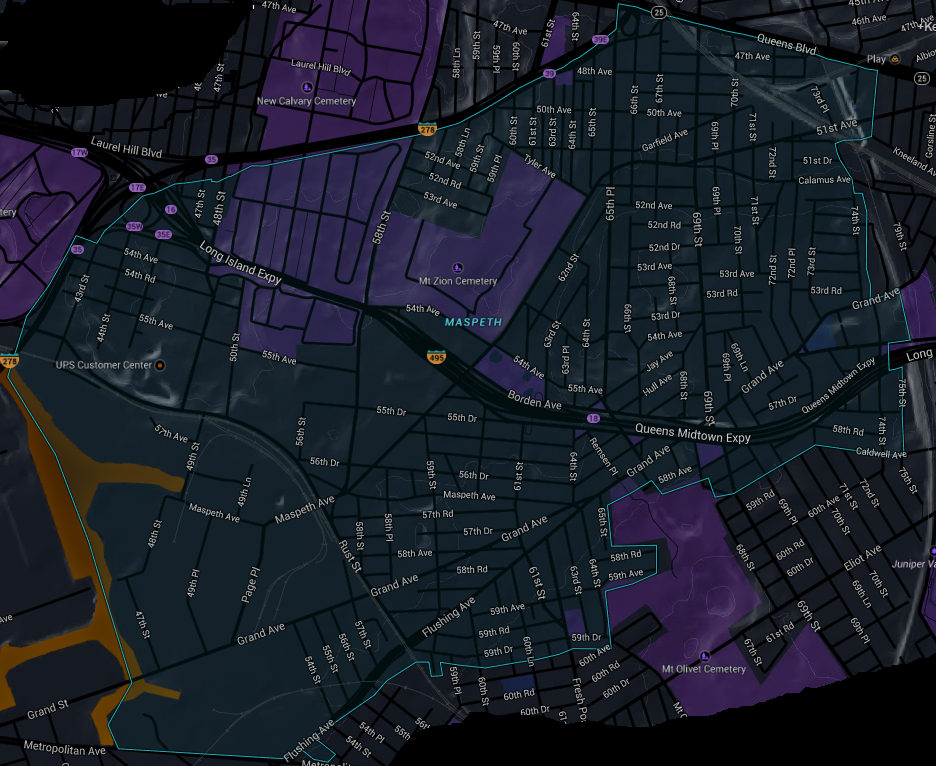Maspeth - Queens

Introduction: Maspeth is a small middle class and commercial community in the New York City borough of Queens. Neighborhoods sharing borders with Maspeth are Woodside and Sunnyside to the north; Long Island City to the northwest; Greenpoint, Brooklyn to the west; East Williamsburg, Brooklyn to the southwest; Fresh Pond and Ridgewood to the south; and Middle Village and Elmhurst to the east.
History: The area known today as Maspeth was chartered by Dutch and English settlers in the mid-17th century. The Dutch had purchased land in the area known today as Queens in 1635, and within a few years began chartering towns. In 1642 they settled Maspat, under a charter granted to Rev. Francis Doughty, making Maspeth the first English settlement in Queens; however, conflicts with the Maspat tribe forced many settlers to move to what is now Elmhurst in 1643. The settlement was leveled the following year in an attack by Native Indians, and the surviving settlers returned to Manhattan. It wasn't until nine years later, in 1652, that settlers ventured back to the area, settling an area slightly inland from the previous Maspat location. This new area was called Middleburg, and eventually developed into what is now the town of Elmhurst, bordering Maspeth.
The name "Maspeth" is derived from the name of Mespeatches Indians, one of the 13 main Indian tribes that inhabited Long Island. It is translated to mean "at the bad water place" relating to the many stagnant swamps that existed in the area.
Columbusville was the name formerly applied to a section of Maspeth. It was a development of Edward Dunn that took place on 69th Place (originally known as Firth Avenue) between Grand Avenue and Caldwell Avenue during 1854–55, and was subsequently absorbed into Maspeth. The name fell into disuse in the 1890s.
Following the immigration waves of the 19th century, Maspeth was home to a shanty town of Boyash (Ludar) Gypsies between 1925 and 1939, though this was eventually bulldozed.
The Community: The Grand Street Bridge carries Grand Street eastward across English Kills from Williamsburg where it becomes Grand Avenue, Maspeth's main street for dining and business. Grand Avenue continues eastward to end in Elmhurst. Cemeteries take up a large part of this small neighborhood although they are separated from residential areas for the most part. Single home houses and multiple dwelling homes make up most of Maspeth and there are few apartment buildings, except for the co-ops on 65th Place, also known as The Plateau.
The area of 43rd Street through 58th Street, including the former Furman Island, is industrial lowlands, and from 60th Street to 72nd Street is residential. The Phelps Dodge Corporation was present from 1920 to 1983. The Phelps Dodge mining company heavily contaminated Newtown Creek, which separates northern Brooklyn from western Queens and serves barge traffic. Other freight moves on the Long Island Railroad Montauk Branch and the lightly-used Bushwick Branch. A new West Maspeth rail freight station has been proposed in connection with a Cross-Harbor Rail Tunnel to diminish truck traffic across New York City. It is opposed by residents who do not want more trucks in Maspeth.
There is access to I-278, the Brooklyn-Queens Expressway and I-495, the Long Island Expressway. The former crosses the Newtown Creek on the Kosciuszko Bridge.
The Elmhurst gas tanks were formerly located in the area, and were demolished in 2001.
Most people who live in Maspeth are of Polish, Italian, Eastern European, Irish, German, Chinese or Hispanic origin. Maspeth is also home to the Metropolitan Oval.
A September 11 memorial has been erected at 69th Street and Grand Avenue to commemorate the local firehouse's casualties from the World Trade Center, which were the largest of any FDNY unit. The monument, adjacent to I-495, faces the World Trade Center site, where the One World Trade Center can be seen. An annual memorial ceremony is held at the monument on September 11.
- Population
- 34,981 (predominately Eastern Europeans)
Transportation: Maspeth is not connected to the New York City subway system and has no station. But it is served by six different bus lines.
- Noteworthy Citizens
- -- Teodor Albescu -- Uncle Teo is the owner and proprietor of Albescu's Pawnbrokers and the neighborhood's only resident centenarian. Uncle Teo immigrated to the New World long ago and has lived in Maspeth as far back as anyone can remember. He often tells stories about the ancestors of the current Maspeth residents as well as of the Old World (Romania), if he has had enough to drink.
- Noteworthy Locations
- -- Laurel Hill -- A sub-neighborhood of Maspeth.
- -- Albescu's Pawnbrokers -- This little pawnshop is owned by Uncle Teo and is run by a variety of his nieces and nephews who are all descendants of the Boyash gypsies.
- -- Politz Delicatessen and Bakery -- This neighborhood delicatessen and bakery has been in business as long as anyone can remember and its cornerstone of the neighborhood.
- Resident Vampires
http://old.wikimapia.org/#lat=40.7231409&lon=-73.9051476&z=15&l=0&m=b&v=8